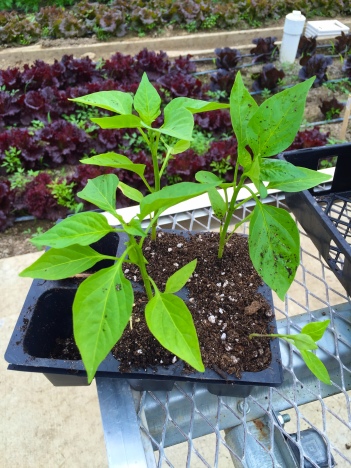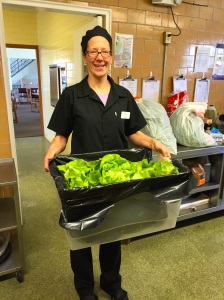
For more regular updates, follow us on Instagram to see what we’re up to on the farm!


For more regular updates, follow us on Instagram to see what we’re up to on the farm!
Performing a Scouting report every two weeks is a necessary function to mitigate the risk of pests, and weeds. Damage of the plants, particular bugs found on the plants and any other noteworthy information is critical to mention in these reports.
It has been amazing to watch the progression of the different plants from mid May up until this point. The fruits of our labor are able to be enjoyed. Using physical labor to put together the growing boxes in the hoop house, and watching the plants flourish. Watching the little baby plants grow up almost brings a tear to my eye. Nurturing these plants with love and care makes the food taste even better.
Another great season of Work and Pick has begun at Eden Hall! Every Wednesday night an AMAZING group of volunteers have been coming up to help us around the farm. Above you can see a few of our volunteers this past week weeding around the perimeter of our movable high tunnel! With so many extra hands, tedious tasks like this take no time.
As half of our crew weeded, the other half filled several wheelbarrows full of leaf mulch and layered it around the potatoes. Why leaf mulch? Mulching helps insulate the soil against heat while also retaining moisture. It will be exciting to watch the potatoes grow as the Work and Pick season continues.
The Progression of the hoop house: Starting by making a level area for the beds, then filling with them with topsoil and compost. Planting the ginger coupled with okra was the next step, and finally finishing the newly transplanted plants with the organic fertilizer to help mitigate the transplant shock.
I want to take a second to highlight the structures that have made our first year of full season extension here at Eden Hall Farm possible. We were able to grow this full past year, thanks to the foundation and support of our four greenhouses. They have weathered wind and rain and withstood the test of time.
Greenhouses come in all shapes and sizes and can range from fairly inexpensive to highly designed structures. The goal and use of a greenhouse for season extension is multi-fold.
The benefits include:
On our farm, we have four different types of greenhouses.
The first greenhouse is our heated glass greenhouse. This greenhouse is used by students for class work and experiments, but is also vital to our farm-to-institution functioning. We used the glass greenhouse warmth this past winter to start and grow seeds and its adjoining building as our harvest wash room.

The second greenhouse is our Solar High Tunnel. This greenhouse is heated by solar energy and has been used the most throughout this past winter to grow our hardy greens, such as kale, spinach, Swiss chard, tatsoi, Red Sail and Rhazes lettuce and is also home to our beets, peppers, and carrots. The Solar High Tunnel is equipped with sliding seeding tables that now hold several trays and gutters of new seedlings. It is also now home to our baby Praying Mantises.
The third greenhouse is our Moveable High Tunnel. This greenhouse is currently growing only kale and Swiss chard, but is being prepped to start production for upcoming summer plans. What is unique about this greenhouse is the ability to slide the entire structure on a set of runners to cover a completely new plot of soil. This is useful for crop rotation and soil preservation.

The fourth greenhouse is our Hoop House. This simple structure is one of the more inexpensive designs, but still provides all of the benefits of season extension listed above. This hoop house was not used through this past winter, but has plans to be tilled and prepared for our new ginger crop.
The diversity at Eden Hall Farm does not stop at its crops (both plants and humans!), but includes its structures as well!

Our Solar High Tunnel has approximately 50 new tenants who made their debut to this world Sunday (under the watchful guardianship of Tony’s son), and were released into the “wild” of our Eden Hall High Tunnel yesterday.

Praying Mantises are utilized as a means of organic pest management. They dine both day and night on many tasty insects. When young, the Mantises eat soft bodied insects like aphids, leafhoppers, mosquitos, and caterpillars, and graduate to larger grasshoppers, crickets and beetles as they age. They are beneficial to the greenhouse as their prey often find prey in our tasty crops.

Our team of baby Mantises was released directly onto our growing Red Sail lettuce, Kale, Swiss Chard, Tatsoi and Spinach.
We hope to observe as they grow and thrive in this environment, though it will be somewhat of an experiment to see how many stay, and how many travel elsewhere once the temperatures rise and the High Tunnel walls start to open and close.
How did Praying Mantises get their name?
(According to Rodale’s Organic Life):
“When lying in ambush for prey, all mantises strike the same ‘prayerful’ posture of folded front legs held tight to the body. They use their back and middle legs to grasp a twig or stem. When an insect comes into reach, the mantis strikes out, impales, and holds the prey with its spiny, or toothed, front legs. The strike occurs in the blink of an eye. A Carolina mantis can actually strike twice before a housefly can open its wings to attempt an escape.”
After their ceremonial send-off by R. Kelly, we moved along in the Solar High Tunnel to seed some Claytonia micro greens and a few experimental pepper seeds.
Today’s chilly temps and gray sky didn’t stop movement at the farm.
We’re “shocking” our shiitake mushroom logs with a cold water plunge to encourage them to fruit.
The logs will remain submerged until tomorrow.
After shocking the logs, we moved to the solar high tunnel to prep a bed for newly transplanted pepper plants.
Just the thought of fresh peppers and mushrooms is enough to make our mouths water!

Spring is the season. As students make their way back to class after break, they find themselves digging through the chaos that are the last weeks of the semester. But the sun is out and the greens are making their way to students’ plates to motivate both their taste buds and their intellectual savvy.
The morning rain didn’t stop the afternoon sun from shining on us as we started our harvest. We pulled lettuce and harvested mizuna, kale and swiss chard from the solar high tunnel. These greens have thrived through the winter with the time, energy and tending from our crew.
They traveled from dirt…

Through a wash…
…and a spin
And straight into the hands of our Eden Hall Kitchen Chefs!

And more greens are on their way to the Shadyside Campus!
-Sometimes the right food takes an equal amount of effort, and today was no different.-
from special contributor, Food Studies M.A. candidate Nick Bender
My name is Nick Bender. I am a second year Master of Arts candidate in the Food Studies program here at Chatham. Most of my school experience has been in the classroom or off-site rather than on the farm. I haven’t spent much time in the green house, the solar high tunnel, or in the agroecology garden. So, when I was told that I would be cooking a meal for 60 people, I thought that this would be a great opportunity to bring together the work that we’re doing at Eden Hall with the work that I’m doing at Vintage.
To give a little background, I am a 2015-2016 Albert Schweitzer Environmental Fellow. I was selected to implement a project to help seniors in an urban neighborhood connect the food that they eat with the impacts on their health and the health of the natural environment. I have been bringing in foods to try and talking about challenges that they face with diet or their eating environment. How many seniors eat alone? How many like to cook? Does anyone grow their own food? I chose Vintage, a senior center in East Liberty. It is a community center that gives seniors an opportunity to gather weekdays from 9-5 for a variety of programming.
Last month I was asked if I could help plan a meal for the Valentine’s Day Blue Jean Dance. The meal was meant to be simple: spaghetti and tomato sauce. Maybe a salad and bread. Done and done. I was trying to figure out how we could keep the integrity of the spaghetti when we had no capacity to cook it to order. I decided that baked pasta would be a better option.
In planning the menu, I realized that if we could get any produce from the farm to use in the meal, I would have a great opportunity to connect the environment with the food that everyone was eating. I reached out to the EHC team, and we were able to get some greens – specifically tatsoi, chard, and 3 varieties of lettuce. Some of the tatsoi went into the baked ziti, and the rest of the greens made up the salad.
A few days before the dance, I started the bread dough. The day before, the EHC team harvested all the greens. They saved me a couple heads, so I could take pictures to accompany my talk. I made the pasta, finished the cookies and the bread the morning of the dance. When I got to the senior center, I was lucky enough to have a few volunteers to help with plating and service. I gave everyone a task, and we began service precisely at 1 o clock.
After the entire dining room was served, I went out and described the food that they were eating. The menu and talking points were as follows:
Baked Ziti, with Tatsoi
This is an update version of the baked ziti that my mother made for us growing up. It is meatless and the tatsoi lends a contrast to the flavor and the texture.
Torn Winter High Tunnel Salad
This blend of tatsoi, chard, and winter lettuces is tossed in a light balsamic vinaigrette.
Sourdough Bread
This bread is a four day recipe from start to finish. The starter culture was inoculated from a vineyard that I had worked on a few years ago.
Heart Shaped Cookie
This is a sugar cookie recipe from a fellow Food Studies student. She is my go-to on dessert recipes.
Basil Limonata
A lemon and basil infused simple syrup, mixed with sparkling water
I told the volunteers to make themselves a plate as a thank you for their work. As the volunteers ate, I addressed the dining room with these broad talking points. Then, I went around to answer any individual questions about the harvest, the preparation, or to share recipes. People seemed to enjoy it, but we may have raised the bar on lunches. So if you know anyone who wants to volunteer, we’d be happy for their help – and we’d feed them quite well in return!